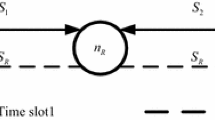Abstract
Error propagation and noise propagation at the relay node would highly degrade system performance in two-way relay networks. In this paper, we introduce DNF–AF selection two-way relaying scheme which aims to avoid error propagation and mitigate noise propagation. If the relay successfully decodes the exclusive or (XOR) of the messages sent by the two transceivers, it applies denoise-and-forward (DNF). Otherwise, amplify-and-forward (AF) strategy will be utilized. In this way, decoding error propagation is avoided at the relay. Meanwhile, since the relay attempts to decode the XOR of the two messages instead of explicitly decoding the two messages, the larger usable range of XOR network coding can be obtained. As XOR network coding can avoid noise propagation, DNF–AF would mitigate noise propagation. In addition, bit error rate (BER) performance of DNF–AF selection scheme with BPSK modulation is theoretically analyzed in this paper. Numerical results verify that the proposed scheme has better BER performance than existing ones.








Similar content being viewed by others
Notes
We assume that the difference between \(P_1\) and \(P_2\) is not large, then successive interference cancelation (SIC) is not suitable.
In the proposed scheme, we donot proceed according to the correctness of the decoded pair. Instead, we proceed according to the correctness of the XOR of the two decoded messages.
Please refer to the Appendix for detailed derivation.
The difference between \(P_r\) and \(P_1=P_2\) is \(0\) when \(\alpha =\frac{1}{3}\). If \(\alpha >\frac{1}{3}\), the increase of \(\alpha \) will result in the increase of the difference.
In the simulations, we first set \(\beta =0.1,0.15,0.2,0.25,0.3,\ldots ,0.8\), and next set \(\gamma =0.1,\ldots ,1-\beta -0.1\) to guarantee that all power allocations are positive.
References
Sendonaris, A., Erkip, E., & Aazhang, B. (2003). User cooperation diversity-part I: System description. IEEE Transactions on Communications, 51(11), 1927–1938.
Laneman, J. N., Tse, D. N. C., & Wornell, G. W. (2004). Cooperative diversity in wireless networks: Efficient protocols and outage behavior. IEEE Transactions on Information Theory, 51(12), 3062–3080.
Zhao, B., & Valenti, M. (2003). Some new adaptive protocols for the wireless relay channel. In Proceedings of the annual allerton conference on communication control and computing, Monticello, IL.
Souryal, M. R., & Vojcic, B. R. (2006). Performance of amplify-and-forward and decode-and-forward relaying in Rayleigh fading with turbo codes. In Proceedings of IEEE ICASSP, Toulouse, France.
Li, Y., & Vucetic, B. (2008). On the performance of a simple adaptive relaying protocol for wireless relay networks. In Proceedings of IEEE VTC-Spring’08, Singapore.
Su, W., & Liu, X. (2010). On optimum selection relaying protocols in cooperative wireless networks. IEEE Transactions on Communications, 58(1), 52–57.
Zhang, T., Chen, W., & Cao, Z. (2012). Opportunistic DF-AF selection relaying with optimal relay selection in Nakagami-\(m\) fading environments. In Proceedings of the 1st IEEE international conference on communications in China (IEEE ICCC’12), Beijing, China.
Rankov, B., & Wittneben, A. (2005). Spectral efficient signaling for half-duplex relay channels. In Proceedings of asilomar conference on signals, systems, computers, Monterey, CA.
Chen, M., & Yener, A. (2010). Power allocation for F/TDMA multiuser two-way relay networks. IEEE Transactions on Wireless Communications, 9(2), 546–551.
Popovski, P., & Yomo, H. (2007). Physical network coding in two-way wireless relay channels. In Proceedings of IEEE ICC’07, Scotland.
Nazer, B., & Gastpar, M. (2011). Reliable physical layer network coding. Proceedings of the IEEE, 99(3), 438–460.
Li, C., Yang, L., & Shi, Y. (2010). An asymptotically optimal cooperative relay scheme for two-way relaying protocol. IEEE Signal Processing Letters, 17(2), 145–148.
Ngo, H. Q., Quek, T. Q. S., & Shin, H. (2010). Amplify-and-forward two-way relay networks: error exponents and resource allocation. IEEE Transactions on Communications, 58(9), 2653–2666.
Yang, J., Fan, P., Duong, T. Q., & Lei, X. (2011). Exact performance of two-way AF relaying in Nakagami-\(m\) fading environment. IEEE Transactions on Wireless Communications, 10(3), 980–987.
Ju, M., & Kim, I.-M. (2010). Error performance analysis of BPSK modulation in physical-layer network-coded bidirectional relay networks. IEEE Transactions on Communications, 58(10), 2770–2775.
Lo, E. S., & Letaief, K. B. (2011). Design and outage performance analysis of relay-assisted two-way wireless communications. IEEE Transactions on Communications, 59(4), 1163–1174.
Chen, W., Hanzo, L., & Cao, Z. (2011). Network coded modulation for two-way relaying. In Proceedings of IEEE WCNC’11.
Koike-Akino, T., Popovski, P., & Yomo, H. (2009). Optimized constellations for two-way wireless relaying with physical network coding. IEEE Journal on Selected Areas in Communications, 27(5), 773–787.
Li, Q., Ting, S. H., Pandharipande, A., & Han, Y. (2009). Adaptive two-way relaying and outage analysis. IEEE Transactions on Wireless Communications, 8(6), 3288–3299.
Chen, Z., Liu, H., & Wang, W. (2010). A novel decoding-and-forward scheme with joint modulation for two-way relay channel. IEEE Communications Letters, 14(12), 1149–1151.
Chen, Z., Kuehne, A., Klein, A., Loch, A., Hollick, M., & Widmer, J. (2012) Two-way relaying for multiple applications in wireless sensor networks. In Proceedings of 2012 international ITG workshop on smart antennas (WSA’12).
Hamdoun, H., Loskot, P., O’Farrell, T., & He, J. (2011). Practical network coding for two way relay channels in LTE networks. In Proceedings of VTC Spring’11.
Zhang, S., Liew, S.-C., & LAM, P. P. (2006). On the synchronization of physical-layer network coding. In Proceedings of 2006 IEEE information theory workshop.
Cripps, S. C. (2006). RF power amplifiers for wireless communications (2nd ed.). Artech House Inc.
Verdu, S. (1998). Multiuser detection. Cambridge: Cambridge University Press.
Zhao, J., Kuhn, M., Wittneben, A., & Bauch, G. (2010). Asymmetric data rate transmission in two-way relaying systems with network coding. In Proceedings of IEEE ICC’10, Cape Town, South Africa.
Acknowledgments
This work is partially supported by the National Basic Research Program of China (973 Program) under Grants 2013CB336600 and 2012CB316000, the NSFC Excellent Young Investigator Program under grant 61322111, MoE New Century Talent Program under grant NCET- 12-0302, Beijing Nova Program under grant Z121101002512051, National Science and Technology Key Project under grants 2013ZX03003006-005 and 2013ZX03003004-002
Author information
Authors and Affiliations
Corresponding author
Rights and permissions
About this article
Cite this article
Zhang, T., Chen, W. & Cao, Z. DNF–AF Selection Two-Way Relaying. Wireless Pers Commun 80, 805–818 (2015). https://doi.org/10.1007/s11277-014-2042-2
Published:
Issue Date:
DOI: https://doi.org/10.1007/s11277-014-2042-2




